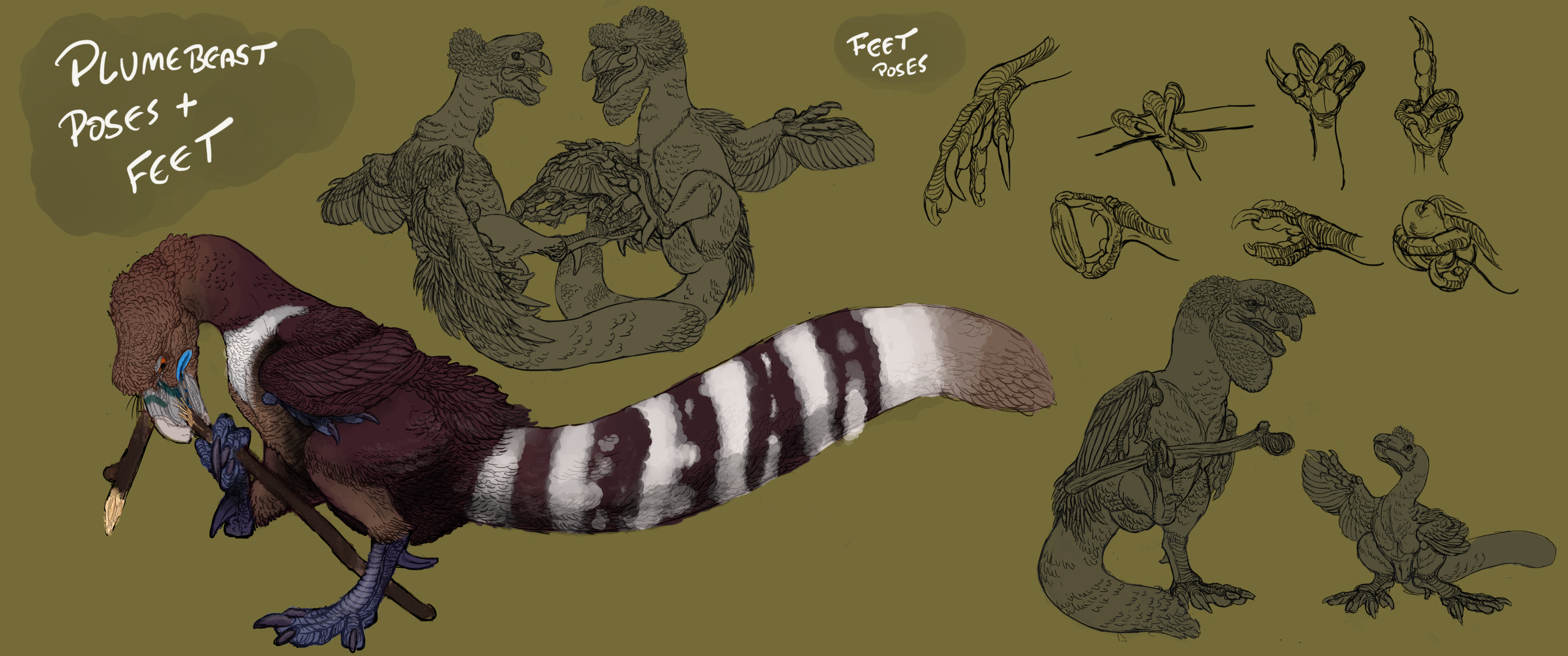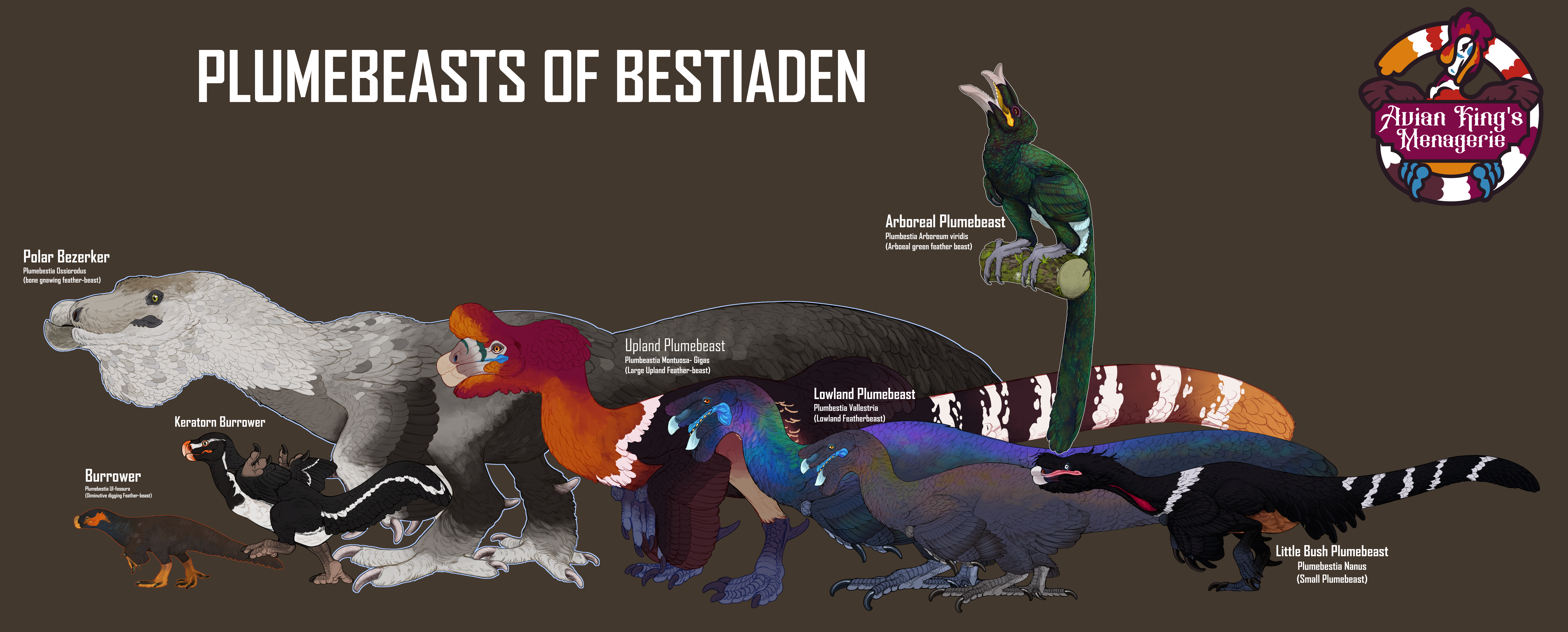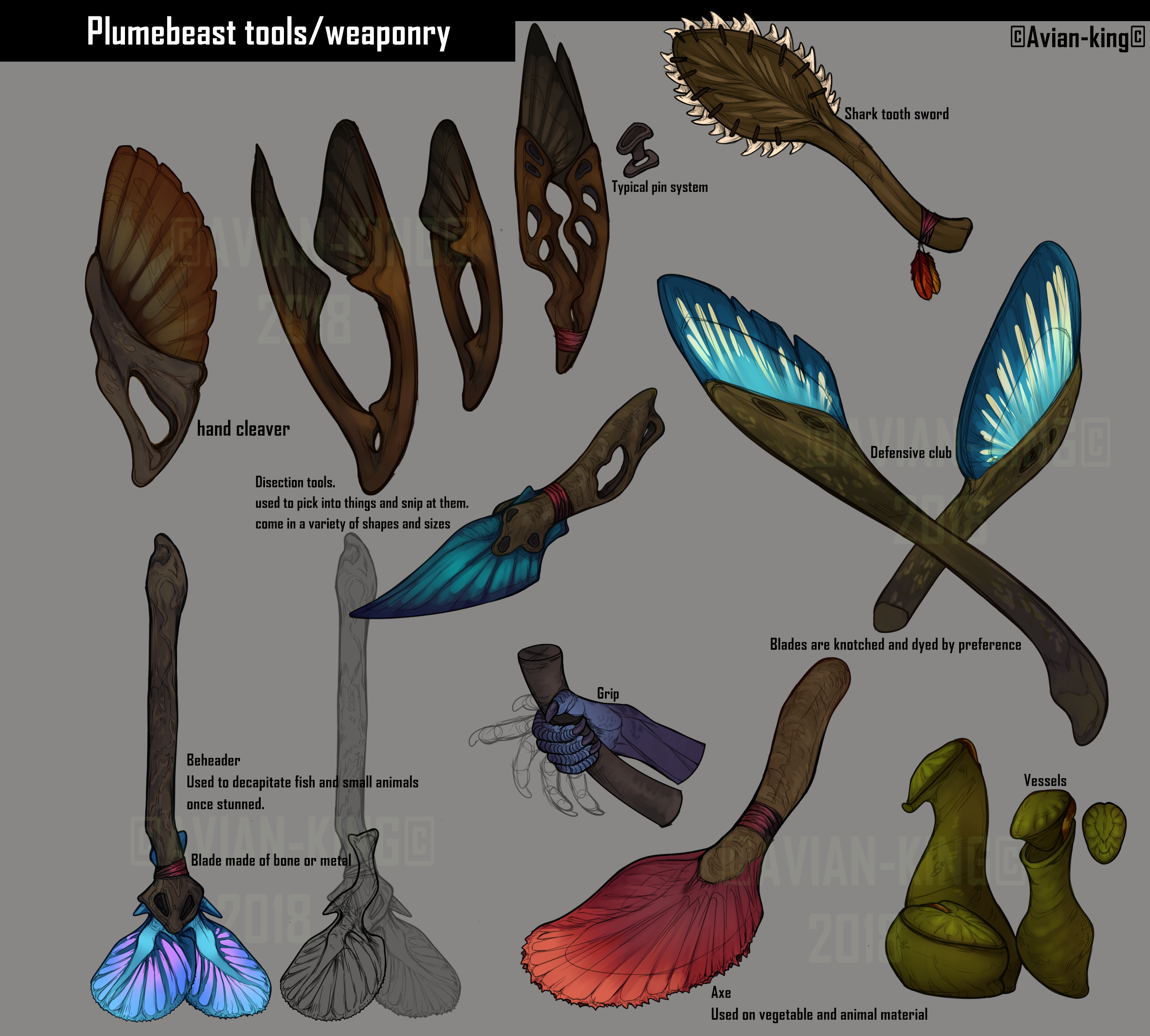Birds sung from the branches of an elder tree. The branches laden with life and splayed with age crawled out across the sky and sank towards the earth at their most distal portions. various epiphytes claimed their perches. from lichens to small cycadophytes. The tree's roots took anchor in stone and soil creating a raised mount. Set into the mound was an irregular door. The door bore fantastic colours and scripts. an equally brightly colored curtain lay just behind the door, decorated with hand painted inklings it shifted with the moment of the unknown force that opened the door, the curtains further parted by the flick of an Ivory-toned muzzle, as it drew forward
As the muzzle drew forward, as did the mass of its rufous owner. Low slung, the creature's' feathered neck flowed down in an elegant S-curve, giving way to a hunched body. Post-pelvis swung a long ringed rail, bouncing as the earth and flame-toned troglodyte took confident steps forward. Once entirely out of the doorway, the plumed thing shook the sleep from his feathers. The beast presented a broad brimmed hat from his side and placed it atop his saurian head with a hook-taloned wing. Pivoting on a scaly blue leg, The beast closed and locked his multicolored door.
The animal removed a fishtailed pipe and matchstick from his axillaries. striking the rod against his door frame, he lit the mashed herbs held within chamber and setting it in-between his rostral dentition. Taking a deep puff of the savory spices, he made his way down the stony mound that made up his hobbit-like den; sulking off towards the fern clearings.
Moa opened the gate to the Aewiriu pen. The olive-green young came galloping up to him as he presented the treat pouch from his tail pack. He uncinched the parcel and drew out minced Kratirant. following the calves, came his favorite cow. Her pace quickened when she saw the pouch hanging from his sacrum. He lovingly called her "Buttercup" Her voluminous crème and brown stippled plumage draped about her body. Moa had raised her from a small calf when he was but an adolescent.
Moa offered her the first handful of Kratirant, reaching above and over the three youngsters before him, letting Buttercup scoop up the soft meat with her predentary.
He then patted her crown with his indigo-blue hand, running his digits through her soft plumage. Buttercup chirruped in comfort as she chewed. He then leaned back onto his haunches and pelvic boot. looking upon the youngsters he offered each a fistful of the chewy flesh.
Glossary:
1. Aewiriu: a variety of new-Iguanadontia covered in semi-plumous feathers and equipped with hooves
2. Kratirant: large land snail, not dissimilar to a geoduck
Basic Information
Plumebeasts are a diverse group of avialan theropods
Plume-beasts stand anywhere from 4-6ft in height occupying niches from primate-like folivores to large tundra predators.
The ancestral form resembled the iconic avialan Balaur Bondonc. This form dwelled in the trees in a similar manner to kakapos, ambling through the undergrowth and feeding on fruits, seeds and foliage in the trees, by use of wing-assisted-incline-running. The diet supplemented by animal proteins.
The ancestral arboreal condition resulted in a theropod with a higher than usual degree of radial flexion as well as classic manual collapse. This was a great adaptation to an arboreal lane of existence, allowing early Plumebeasts to practice a certain degree of brachiation. Their body tails were highly mobile at the base to act as a counter-weight as they moved across or under branches.
The feet of this ancestral form were pamprodactyl. the hallux (1st toe) get more muscular and the innermost (4th toe) became much more flexible. This allows two very useful arboreal and terrestrial pedal conditions. In the tree's a light individual can support themselves quite easily by reversing two of their toes, on the ground all 4 toes can come forward.
All species excluding the arboreal and burrowing forms have spurs on their tarsometatarsals. The spurs are used in interspecific combat and defense. spur development is a male trait, though some females do develop them.
The hands of the species are unusual in that they bear 4 digits. Far back in the evolutionary chain the polydactylous mutation took a strong hold in the gene-pool. The benefit of a an extra unclawed digit was multi-fold. They work well in the trees and for food manipulation. but also allow tools to be braced to the other digits or arm.
In the burrowing and Polar varieties have grown pronounced claws similar to spurs or picks on their first digit for combat, excavation and prey suppression.
The Upland, Lowland and Little bush plumebeasts (closely related) all bear clubs of varying size and dimensions on their manual extensors processes.
Plumebeasts are seasonal breeders, choosing the most fecund periods in their ranges to propagate. The shape and colouration of the eggs produced varies between species. Polar giants lay pointed eggs varying from white to cereulean blue and sprinkled with unique patterns. Uplands lay large pill shaped eggs within the green and blue-green range. Lowland Plumebeasts lay gorgeous blue eggs that may or may not be spotted. Little Bush produce eggs rich in carotenoids, these eggs are spotted and vary from terra-cotta to a rich golden brown. These are surprisingly large for size of the parent beasts. Burrowers tend to lay near-spherical olive green or grey eggs. Compared to all the other species the Burrowers lay the largest quantity of eggs. Arboreal Plumebeasts (Plumebestia Aboreum Viridis) lays an unspectacular creme coloured egg with dark spots and sprays throughout. These eggs may be a rusty colour depending on parent diet.

Plumebeasts do not practice the same types of brooding found in modern terran (earth) birds. Much like some more derived archosaurs they practice compost nesting. There is species variation in play as well, as Burrowers do not practice microbial respiration during incubation, and Arboreals have taken to creating nesting colonies that only partially make use of compost.
three to eight large and colourful eggs are laid in the center of the mound on heaps of rotting vegetation. The eggs act as a beacon and stimulant to passing females, who then mate with the resident male. A successful cock-beast will have a female yield of 3-4 hens. Once all eggs are laid, an insulating layer of sand and rotting wood is layered on top of the eggs and removed and added as temperatures fluctuate. Both sexes monitor the mound, although males take a leading role.
Upon hatching the chicks use their powerful claws to break out of the egg, and then tunnel their way up to the surface of the mound, lying on their backs and scratching at the sand and vegetable matter. The parent animals do not aid in this process as it is believed that chicks that cannot survive hatching will not survive life thereafter.
Plumebeasts are superprecocial, hatching from their eggs in the most mature condition possible. They hatch with open eyes, with bodily coordination and strength, with full wing feathers and downy body feathers, able to run, and pursue prey. These supercharged chicks are greeted by their parents upon breaching the mound. The male and any females who stuck around during the incubation period help raise the chicks. Teaching them how to hunt larger game, make tools, tame mounts, rear livestock animals, and socialize. In this way language and culture can be passed down effectively.
Plumebeasts occur in a wide range of habitats throughout Bestiaden. From cloud forests to polar wastes.
The Dietary needs vary between the species.
The upland and lowland temperate forest varieties are very opportunistic subsisting on a diet of large snails, sauropods(rarer), ceratopsians, and whatever fish and plant proteins they can locate.
Burrowing Plumebeasts have developed chiseling fangs similar to th3e extinct crocodilian pakisuchus. These are used to pry off chunks of tubers and vegetables, though they are just as good at putting holes into terrestrial mollusks.
The Polar Plumebeasts (Ptilosis Bestia Collosolestes), consumes only meat; that of rare polar grazers and amphibious or aquatic prey items.
The Rainforest arboreal species feeds on nectar, fruit and seeds exclusively. Making them experts on seasonal trends in plants.
Additional Information
Social hierarchy and construction varies between species, much like the various seen in parrots and ratites.
Plumebeasts are capable of great chemo-reception. Like many reptile-derived species they have a well developed Jacobson's organ as well of olfactory canals. A trait common to the order is multiple "nares" on either side of the maxilla. It is believed that this composition allows individuals to pick the direction and flavor of food items form a fair bit away.
Civilization and Culture
Plumebeasts are capable of constructing tools and simple machines. Various tools such as prying implements, hunting blades, clubs, vessels, beheaders, scissors, shovels and fishing gear have been devised.
Plumebeasts use their knowledge of bird nesting to construct woven gates, cages and pens to contain stock animals and reinforce dens or canopy dwellings. The diminutive rainforest variety of Plumebeast has created woven nests adorning great browsing mounts allowing them to move whole communities to wherever food is most abundant.
Tools are wielded in the hands, beak or feet (the feet being the most manipulatory).
Plumebeasts have adopted many species under them as steads, beasts of burden, pets, and livestock. Some being hatched in the same nesting mounds as the beasts themselves, further intertwining their kinship. Tribes may even make it a right of passage to have a specific animal bound to a chick at birth.
One of note is the "Knife-heads" (Pelorocutltrovenator) these are advanced carcharodontosaurs that have developed in this world. The and other tissues of the maxilla, premaxilla and (pre)dentary have grown into sharp and powerful shearing surfaces comparable to great cleavers.
In practice the beast's jaws are of great use during Sauropod hunts. Their cutting beaks slice into the flanks and limbs while their riders move in with hooks and blades to finish the job.
Plumebeasts of the temperate forests (high and lowland) have access to a few varieties of "snail crocs", a group of large herbivorous or omnivorous crocodilomorphs with builds not dissimilar to advanced synapsid reptiles such as Moschops.
(One such snail croc)
The rainforest arboreal plumebeasts(Ogluk) have adopted sauopods as not only mounts, but mobile townships






